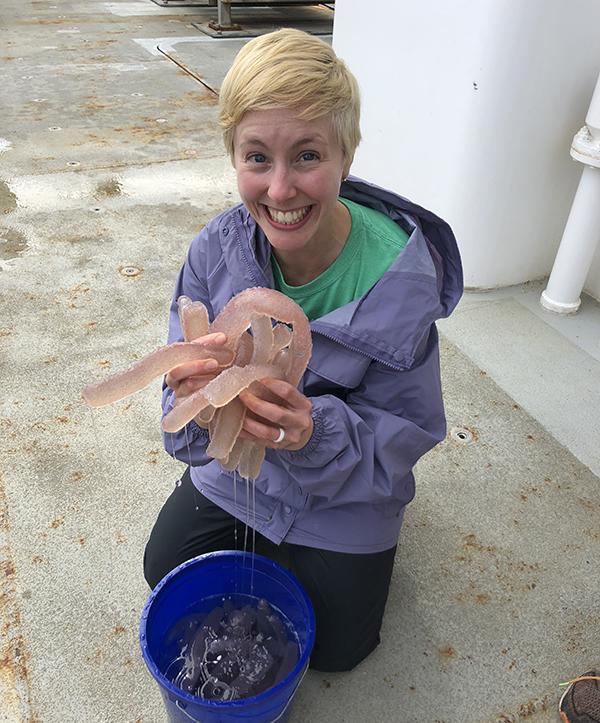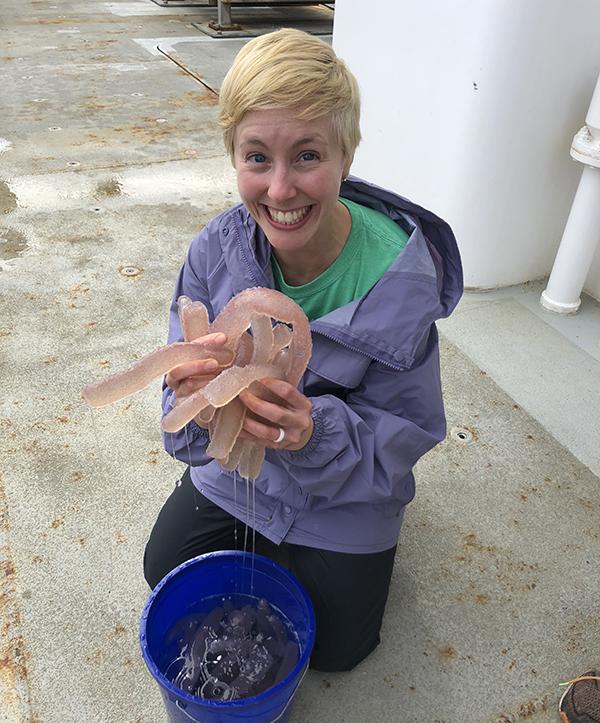
Credit: Photo by Kelly Sutherland
EUGENE, Ore. – July 20, 2018 – Tubular colonial jellies known as pyrosomes that arrived in 2014 along North America's Pacific Northwest Coast appear to be adapting to cooler water and may become permanent residents.
That, a five-member research team concludes in a study in the journal Ecology, could mean a continued nuisance for regional fishing operations and changes to energy flows that could alter long-existing near-shore food webs.
"These animals may be able to survive in colder water than we previously thought possible, but what might really be contributing to their continued presence is that the food source off of our coast is right for them," said study co-author Kelly Sutherland, a marine biologist at the University of Oregon.
UO graduate student Hilarie Sorensen, the study's other lead author, helped document the invasion by these "sea pickles," as pyrosomes are commonly called, during a research cruise in 2017. That prompted a deeper exploration.
Marine biologist Aaron Galloway was a third UO scientist on the research team. All three are with the Oregon Institute of Marine Biology at Charleston.
"The last few years have been relatively warm," said Sutherland, who also is with the UO's Clark Honors College and Institute of Ecology and Evolution. "The warmth on the surface tends to keep colder, denser, nutrient-rich water from reaching the surface; it's an oil-and-water kind of situation."
"These relatively nutrient-poor conditions lead to smaller prey particles that pyrosomes can capitalize on," Sorensen said. "This could be systemic of larger changes in the ecosystem."
Pyrosomes are made up of small, multicellular organisms, linked into a tunic to form a colony shaped like a tube. They are filter feeders that use cilia — tiny, hairlike projections — to draw plankton into their mucous filters. The ones seen off Oregon in 2017 ranged in size from about an inch to more than 2 feet long.
In their new paper, the researchers noted that pyrosomes – a name refers to their fiery bioluminescence — are "one of the least-studied planktonic grazers in spite of their widespread distribution and ecological significance."
Researchers in Sutherland's lab have been involved in recent efforts to understand filter-feeders.
Until 2014, the creatures were common in warmer waters south of California's Cape Mendocino. They possibly then began moving up the coast into the Pacific Northwest as part of a multi-year "warm blob" that was followed by a strong El Nino in 2016, the researchers noted.
During a research cruise in February, pyrosomes were found amassed in large numbers at three separate locations, six, 15 and 28 miles offshore from Newport, Oregon, where the water temperature was about 50 degrees Fahrenheit. The jellies were found at the base of the surface layer at a depth of about 130 feet.
Fish, sea turtles and sea birds are among predators that have been seen feeding on the sea pickles along the Pacific Northwest coast. In the Gulf of Mexico and off the British Columbia coast, anemones, sea urchins and crabs have been observed eating them.
Their continuing presence and their capacity to reach bloom proportions, the researchers wrote, suggests that pyrosomes may be thriving in colder waters and could become more permanent residents in the California current, which extends from near Baja, California, to off southern British Columbia.
Summer 2017 was difficult for the Pacific Northwest fishing industry as both live and dying sea pickles were captured in large numbers by trawling nets, requiring time-consuming sorting and removal. Potentially, Sutherland said, some fishing operations could face relocation.
Large-scale aggregations of sea pickles can potentially restructure energy flows by their removal of photosynthetic plankton through consumption at higher levels of the ocean food web, subsequent fecal pellet production and sinking as they die off, the researchers noted in their conclusion.
Other study co-authors were Olivia Blondheim of Drew University in Madison, New Jersey, and Richard Brodeur of the National Oceanic and Atmospheric Administration's Northwest Fisheries Science Center at Oregon State University. Blondheim was supported by NOAA's Ernest F. Hollings Scholarship Program while a 2017 summer intern with Brodeur and Sutherland.
Sutherland's research group gathered pyrosomes during two research cruises this year – in February and July – as part of a National Science Foundation-funded project with Oregon State University to study zooplankton in the northern California Current, which runs along the west coast of the United States. OSU's team is led by Bob Cowen, director of the Hatfield Marine Science Center, and Su Sponaugle, a professor in the Department of Integrative Biology.
###
In addition to the National Science Foundation, the newly published study was supported by Oregon Sea Grant and the Northwest Fisheries Science Center.
Source: Kelly Sutherland, assistant professor in the UO Department of Biology, Robert D. Clark Honors College and Oregon Institute of Marine Biology, 541-346-8783, [email protected]
Note: The UO is equipped with an on-campus television studio with a point-of-origin Vyvx connection, which provides broadcast-quality video to networks worldwide via fiber optic network. There also is video access to satellite uplink and audio access to an ISDN codec for broadcast-quality radio interviews.
Links:
About Kelly Sutherland: https://biology.uoregon.edu/profile/ksuth/
Sutherland's lab: https://www.sutherlandlab.org/
Media Contact
Jim Barlow
[email protected]
541-346-3481
@UOregonNews
http://around.uoregon.edu
Related Journal Article
http://dx.doi.org/10.1002/ecy.2429





